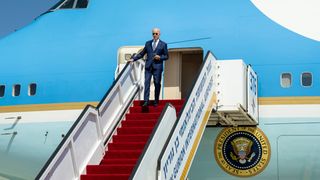With Asia’s ‘summit season’ upon us, new research from the United States Studies Centre (USSC) at the University of Sydney finds the Biden administration’s engagement in the Indo-Pacific has been roughly on par with the first 18 months of the Trump administration. Faced with a deteriorating regional strategic environment, competing global demands, and with growing regional concern for US isolationism, the need for senior US officials to ‘show up’ in the region – and the obstacles to doing so – have rarely been greater.
In Dedication or distraction: Comparing US Indo-Pacific engagement under the Obama, Trump and Biden presidencies, USSC Research Associate Alice Nason quantitatively contrasts the Biden team’s first 18 months of Indo-Pacific diplomacy with that of the first 18 months of the Trump administration and the second Obama administration. The research catalogues 1,290 instances of senior US diplomatic engagement globally since the Obama “pivot”, later “rebalance,” to Asia began.
Foreign Policy and Defence Program Director Professor Peter J. Dean noted, “this is a timely consideration of whether the Biden administration has been able to marry its rhetoric to reality when it comes to senior officials’ diplomacy in the Indo-Pacific.”
The paper’s author Alice Nason said, “in the face of an array of challenges, the COVID-19 pandemic foremost among them, the Biden administration should be commended for restoring predictability to the US diplomatic calendar in the Indo-Pacific.”
The scale and ambition of senior officials’ engagement in multilateral and minilateral configurations is especially remarkable, with President Biden and his cabinet secretaries attended all major regional summits and convened 49 formal sidelines meetings with Indo-Pacific partners. For comparison, under 18 months in the Trump and Obama administrations and in the absence of COVID-19 conditions, attendance was inconsistent, and 47 and 33 sidelines were held respectively.
Though President Biden did not match his predecessor’s rate of travel or phone call correspondence, the administration at large was a diligent dialogue partner for democratic allies in the region. Australia has been the greatest beneficiary of increased high-level attention, with senior officials being hosted in Washington DC on five occasions.
However, while the Biden administration did narrowly exceed the Trump administration’s total number of senior engagements with Indo-Pacific partners over 18 months, in some respects its engagement has dawdled.
Nason found that, when compared to its predecessors, “the administration concentrated its diplomatic energies in Europe and presidential travel and phone call correspondence has been subdued.” A lack of focus on the Indo-Pacific and a minimally engaged president call into question the administration’s claim that the Indo-Pacific is the United States’ region of primary importance.
Key points
- President Biden himself took 16 months to make his first visit to the Indo-Pacific, while he was a regular visitor to Europe throughout his first 18 months in office. He scheduled 11 meetings with European heads of state in Washington DC, while only hosting 7 meetings with Indo-Pacific leaders.
- President Biden, Secretary Blinken and Secretary Austin’s combined 233 engagements with Indo-Pacific partners over their first 18 months narrowly exceeded the Trump administration’s 228 engagements and the 114 engagements attested to by available Obama administration records over the same duration.
- The Biden administration stands apart from its predecessors for its consistent regional summit attendance and 49 associated sidelines meetings, where the Trump administration held 48 and the Obama administration convened 33 in the absence of pandemic conditions.
- President Biden and his appointees secured regular meetings with traditional democratic allies in the Indo-Pacific. More senior Australian officials have been hosted by their US counterparts than from any other country, or than in the initial period of any previous administration.
- However, wider regional engagement, particularly with Southeast Asia, was delayed and negligible at the presidential level in the administration’s first 18 months. Unlike both of his predecessors, President Biden held no phone call with, and conducted no visit to, a Southeast Asian country in his first year.
- The 22 visits President Biden, Secretary Blinken and Secretary Austin undertook to Indo-Pacific countries were surpassed more than three times over by their 70 visits to Europe – in no small part attributable to Europe’s geographical proximity to the United States, looser pandemic-based border restrictions, more institutionalised alliances and the need to response diplomatically to the invasion of Ukraine.
Media enquiries
USSC Media
T 0468 480 165
E ussc.media@sydney.edu.au





